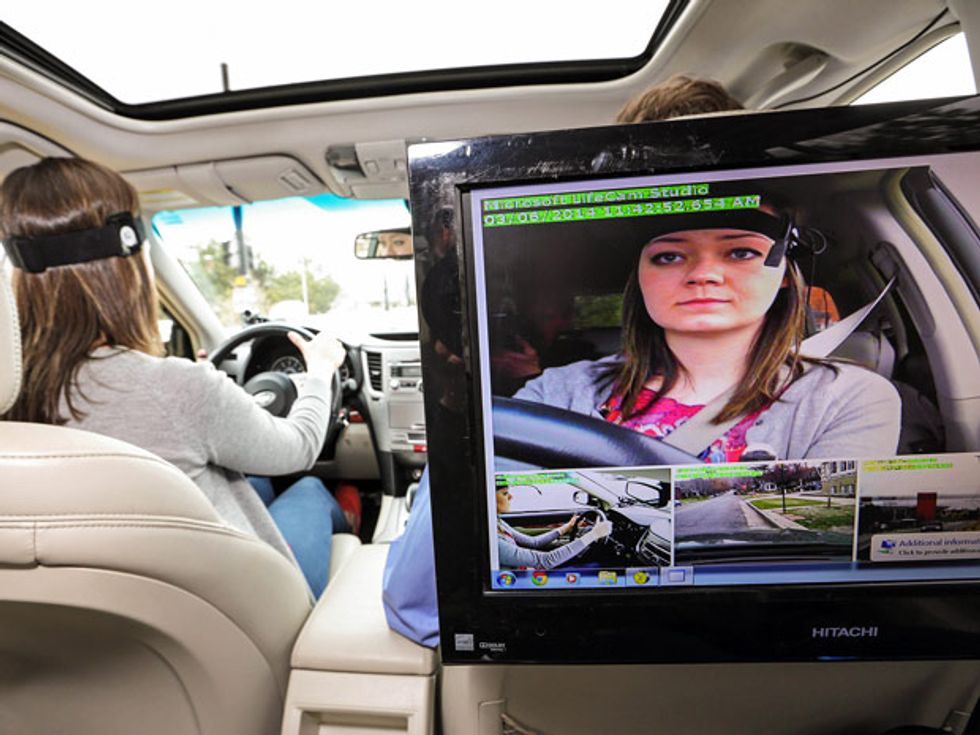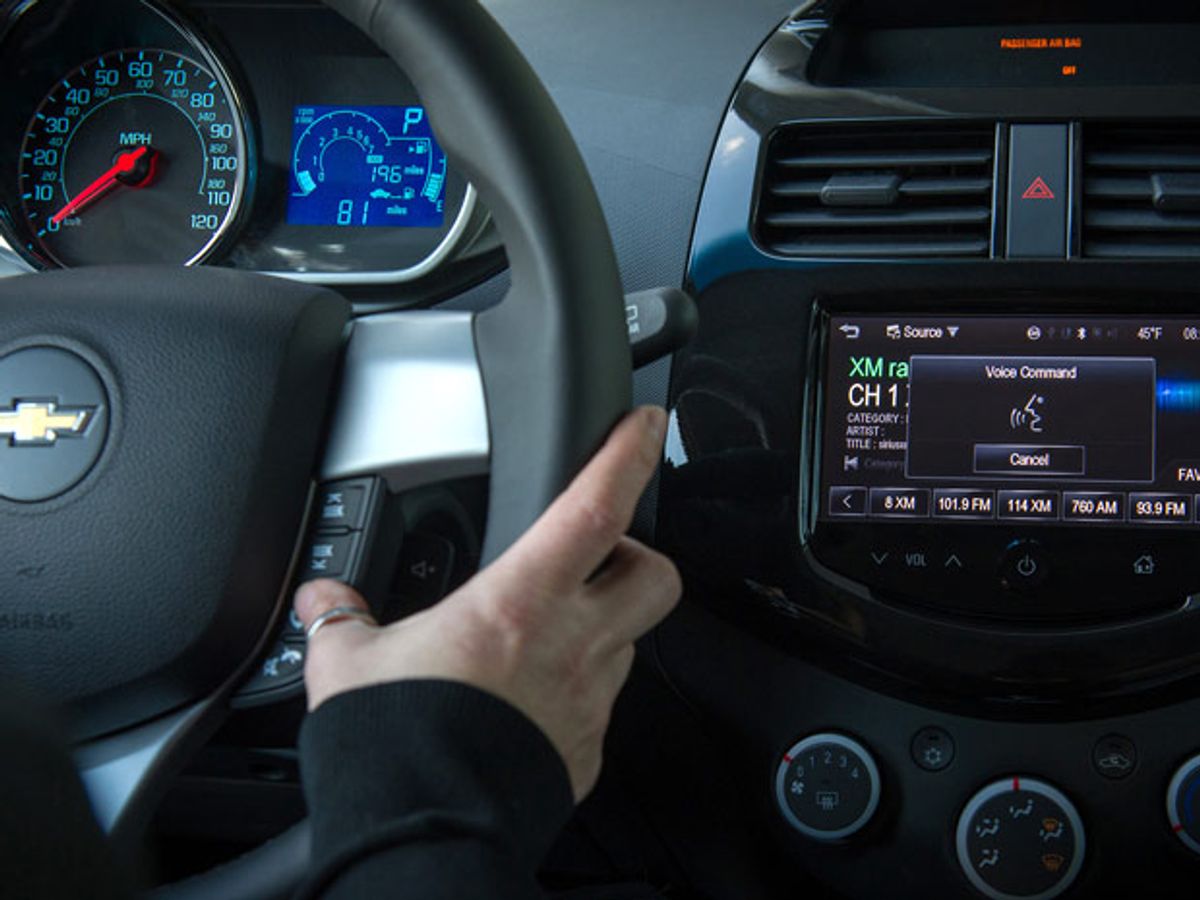Ever since Knight Rider introduced us to its star car, KITT, in 1982, a car we can talk to has been high on many drivers’ sci-fi wish lists. Some of today’s models do respond to spoken commands from drivers. And while talking to your car can be convenient, a series of tests conducted by University of Utah researchers found that talking to voice activated devices like smartphones and dashboard computers can be a dangerous distraction for drivers.
Researchers looked at two different kinds of voice-control in two different studies, which follow up on previous work that, like these studies, was sponsored by the AAA Foundation for Traffic Safety. In the first study, they observed how interaction with dashboard-based “infotainment” systems in cars from five different auto manufacturers (Chevrolet, Chrysler, Ford, Hyundai, and Mercedes) affected driver response times. They also examined how drivers reacted when listening to and responding to text messages and emails relayed to them by Apple’s voice-controlled digital assistant, Siri. You can read the full reports here.
162 drivers chatted with their smartphone servants and dashboard computers in a series of three experimental setups: a laboratory, a driving simulator, and a car driving around neighborhoods in Salt Lake City. The difficulty of various tasks, including listening to text messages read by a computer and navigating a menu using voice commands, was rated on a scale of one to five points. These numbers represent the mental workload the activity subjected drivers to, with a score of one comparable to driving with no distractions and a score of five comparable to solving complicated math problems while behind the wheel. Levels of driver distraction were determined by measuring factors like heart rate and response time.
For in-dash computer systems that let drivers control car functions with their voices, University of Utah researchers led by psychology professor David Strayer tested how much attention it took for drivers to accomplish common tasks like changing radio stations or dialing phone numbers.
“The basic root question is can you make these techs so they’re not demanding and safe to be used,” Strayer told IEEE Spectrum. To learn that, the team had to figure out how safe they are right now, and what factors impact that.
Strayer and his colleagues found that the distraction associated with in-dash systems was closely tied to how well those systems understood spoken commands. Generally speaking, results showed that the better the voice recognition in a system, the less distracting it was to drivers. They also found that regardless of the system being used, listening to messages was less distracting for drivers than composing responses.
Among in-dash computer systems tested, Toyota’s Entune distracted drivers the least, with a score of 1.7 points on the workload scale — about the equivalent of listening to an audiobook while driving. With a workload rating of 3.7 points, Chevrolet’s MyLink system, described by Strayer as “almost unusable” had the poorest performance in the tests.
“We had people trying to change the radio station and changing the temperature instead,” Strayer says, noting that the system left some testers hurling four-letter words instead of requests following a string of misunderstood voice commands.

The results didn’t come as a surprise to AAA officials who sponsored the study. “We already know that drivers can miss stop signs, pedestrians and other cars while using voice technologies because their minds are not fully focused on the road ahead,” said Bob Darbelnet, chief executive officer of AAA. “We now understand that current shortcomings in these products, intended as safety features, may unintentionally cause greater levels of cognitive distraction.”
Apple’s Siri, running on a modified version of iOS 7, scored the worst in testing, with a 4.1 point workload rating. That’s several steps up in mental workload from just talking on a cellphone, and just shy of the top of the scale, which Strayer described as “like trying to balance your checkbook” while driving. In a statement, Apple pointed out that drivers in the study were not taking advantage of available software to optimize Siri for use behind the wheel.
The study also found that, contrary to previous studies, listening to messages read by natural human voices and synthetic, computer-generated ones occupied drivers to the same degree. Older studies had found synthetic voices to be more distracting to drivers, suggesting to researchers that improvements in computer-generated voice quality in recent years have helped to close that gap.
“The technology on the text-to-speech part has improved to the point where it’s no longer part of the problem,” Strayer says. But, he adds, even as technology improves,“ ... there’s only so much room for improvement before we reach the limits of what the brain can do.”
That doesn’t mean we should abandon voice command technology, which is obviously something consumers want, Strayer says, but it should make us think about how we put it to use. “It would be a mistake to throw the technology out. It clearly has promise,” he tells IEEE Spectrum. “But there are a lot of issues with the technology that need to be solved, too.”
Some of those issues, Strayer says, are technological hiccups that can be ironed out. But others are thornier psychological concerns over how much outside input and interaction the human brain can manage while driving.
Strayer has a couple suggestions for car manufacturers to make these systems safer and less distracting. Designers can cut the physical clutter to make sure people keep their eyes on the road, and place a premium on user interface — menus should be easy to navigate, and reliably respond to commands to mimize user frustration.
In addition, he says, voice interactions with a car should be short and directly related to driving. Being able to change the temperature inside a car without reaching for a knob or button is probably a good feature, he says. But sending a tweet or posting to Facebook should probably wait until you’re no longer operating an automobile.
Strayer also pointed out that in-car systems are not as easy to upgrade as mobile devices, often requiring a trip to the dealer if they can be upgraded at all. That means someone who buys a car with a poor voice control system could be stuck with it for the life of the vehicle, which tends to be much longer than the life of other devices like smartphones or personal computers.
“This technology is something that is meant to make your car stand out,” says Strayer. “What I think the automobile industry is about to find out is that if it’s frustrating and you’re swearing at it, it might make your cars stand out for the wrong reasons.



